On January 13 my Stargate Egypt Tour loaded up in New York and for two weeks our entourage of 30 artists, musicians, writers, poets, healers, engineers (and, of course, a compliment of Magdalenes, Hatshepsuts and Moses’s!) ventured through the temples of ancient Khem, showing the gods everything we’ve got. It was an incredibly inspiring time, to say the least. (Seats are available for my April ’08 Stargate Egypt tour.) I was able to further my research into the ancient Osiris Stargate Device.
Our trip, expertly facilitated and guided by Mary Lomando and professionally orchestrated by Abercrombie & Kent, was timed so that we would be at the altar of the Sphinx for the full moon in Leo. An astrologer who joined the trip told us this full moon was an opportunity to receive Christed energy in a big way. Hmm. When I think of Christed energy I think of pure joy. From the smiles on the faces in the picture below I’d say we nailed it!
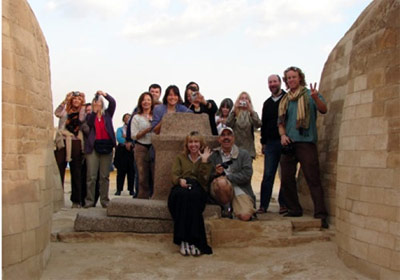
Part of the Stargate Egypt entourage at the altar between the paws of the Sphinx
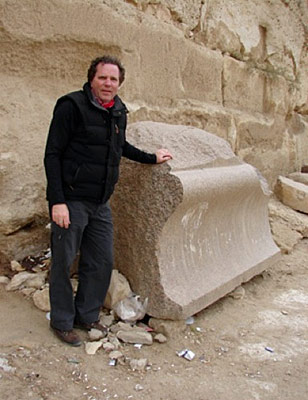
“What the bleep?!” A tremendous anomaly is found at the Valley Temple beside the Sphinx. Who could shape this 50 plus ton red granite block and polish it to such a perfectly smooth surface? How did they do it?
After our visit to the Sphinx, we enjoyed private time inside the Ascension Room of the Great Pyramid.
In my life, nothing compares to the experience of meditating in this great red granite womb and beaming magnified love energy to my family and loved ones. Sitting at the exact geographical center of the landmasses of our planet (and designed to focus her energies), the Ascension Room (aka the King’s Chamber) takes you to a remarkably focused level of mind.
This time, I imagined activating the pyramid itself by feeling waves of love radiating from my heart and illuminating the Pyramid, ala the All Seeing Eye on the Great Seal of the United States. As I was doing this, one of the women on the tour, an intuitive and healer, suddenly marched over to me and tapped my shoulder. Am I in trouble? I asked. No. She said she just wanted to bathe in the shaft of light pouring through my crown chakra! Whew! You just never know! As Nike says, you just gotta do it.
BTW, I’m proud to say I ran the steps of the steeply slanted Grand Gallery (angled at a steep 26.3 degree) twice! Yeah Baby! ‘Course my thighs were talking to me for a day or so after.
Egypt unexpectedly ‘called’ me to return last Summer. After my May ’06 tour I was fairly sure that I wouldn’t return to Ta-Mera (‘land of waters’ or ‘land of love’), as Egypt was called, for a while.
That abruptly changed with my Dreamland interview with Catherine Dees, author of Omm Sety’s Egypt. Her co-author, Hanny el Zeini, was the life long friend of Omm Sety, the Englishwoman formerly known as Dorothy Eady, who mastered the secrets of Egypt’s most sacred place, Abydos, and left a remarkable testament to a time and place mostly long forgotten. I was anxious to return to Abydos to further my research. I’m grateful to Mr. el Zaini, who joined us for an evening in Cairo.
Omm Sety’s story is alluring. After a childhood accident, she began having recollections of a life in ancient Egypt. As this life revealed itself, she learned she had been a vowed priestess of Isis in the court of King Sety, the 16th century B.C. Egyptian pharaoh who built the temple at Abydos. A forbidden relationship led to a unwanted pregnancy. To protect the king the young priestess took her life, leaving Sety wrecked, suffering, cut in two, a hollow and haunted man.
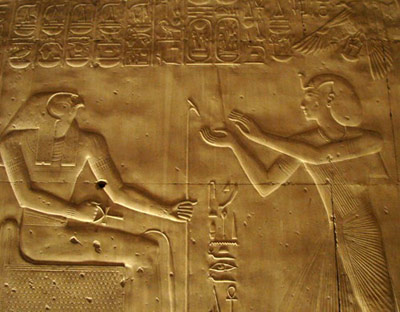
Sety offering ‘bread’ to Sokar. He wears the transparent ‘robe of light’, indicating he was an initiate of the Egyptian Stargate Mystery Schools
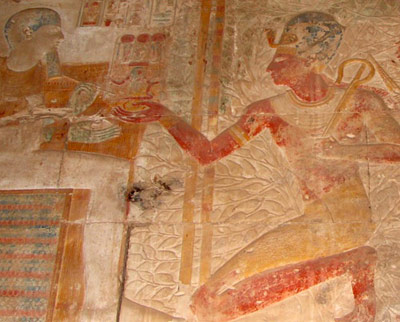
Sety (kneeling) in a sycamore tree receives the symbol of millions of years or immortality from Ptah seated on his throne
OSE tells Dorothy Eady/Omm Sety’s story of her current-era relationship with the illuminated King Sety. Beginning in the early 1900s and lasting until her death in 1981 the ancient king and the woman from Victorian England carried on the romance begun in 1500 B.C.
He usually appeared at night. They would talk about the things normal couples discuss. They often made love. Her body’s sekhem or life force supplied the power. He felt “real” in a “virtual” way to her. Then, he would disappear all of a sudden, crossing our 3-D world into the parallel reality the ancient Egyptians called Amenti, the realm of Osiris.
One fact makes Omm Sety’s story incredibly compelling. That is the greatest Egyptologists of her day, including the esteemed English Egyptologists E.A. Wallis Budge and William Flinders Petrie, acknowledged that Omm Sety possessed astonishing and verified knowledge about ancient Abydos beyond attribution to any known source. She maintained she remembered ancient Abydos and that Sety himself revealed its secrets to her.
Omm Sety’s story left me accepting the impression that the great king was so devastated over the loss of his priestess that he waited for or searched for over 3,000 years until, at last, he found his eternal love had reincarnated in England in 1904.
History dovetails with this inkling and reveals an incredible sense of destiny or cosmic timing about Dorothy Eady/Omm Sety’s reunion with Sety. Consider this chronology.
In 1817 Sety's phenomenal tomb (KV17) was found by Giovanni Battista Belzoni in the Valley of the Kings. His huge alabaster sarcophagus, carved in one piece and intricately decorated on every surface (including the goddess Nut on the interior base), was taken to Sir John Soane's Museum, in London, England. Soane bought it for exhibition in his open collection in 1824. (The museum tells me they are preparing a book about the sarcophagus for publication soon.) I’m planning on visiting the Soane during my Scotland/UK tour in August.
Then, in 1881, Sety’s extremely well preserved mummy was found in the mummy cache (tomb DB320) at Deir el-Bahri (and has since been kept at the Cairo Museum). Examination revealed that he appears to have been less than forty years old when he died unexpectedly.
Sety’s early death is a bit of a mystery considering his sons lived to advance ages. Intriguingly, it has been suggested that he died from a disease, which had affected him for years, possibly related to his heart. As if to emphasize the heart connection, Sety’s heart was found placed in the right side of his mummified body rather than the usual left. Some say that this was intended to assist Sety in using the energy of his heart in an amplified way in the afterlife. (Personally, I think he performed the Endura, the conscious death, but that’s for another time.)
Dorothy Eady was born in London, England in 1904, the very same place where Sety’s sarcophagus was delivered some eighty years before.
Based on Eady’s story one wonders if Sety was somehow orchestrating these events from behind the scenes?
Omm Sety’s story, and the mystery it emits, captures the heart and mind.
As Jonothan Cott, author of The Search for Omm Sety: Reincarnation and Eternal Love with Hanny El Zeini, tells it at his first meeting with his editor at Doubleday, Jacqueline Onassis, they both pulled out a worn clipping of a New York Times story about Omm Sety.
As I noted to my Stargate Egypt group at my first lecture in Aswan, from her apartment windows in New York Jackie O had a splendid view of a glass-enclosed wing of the Metropolitan Museum of Art, which displays the Temple of Dendur, a Nubian temple built during the Roman period around 15 B.C. It was dedicated to the goddess Isis, the gods Harpocrates and Osiris.
This was a gift from Egypt to the United States in gratitude for the generosity of the Kennedy administration, who had been instrumental in saving several temples and objects of Egyptian antiquity that would otherwise have been flooded after the construction of the Aswan Dam.
It was Mrs. Kennedy who personally chose the Temple of Dendur, now a centerpiece of the Met's collections, as Egypt's gift to the United States. “That’s my temple,” she is said to have declared upon seeing it for the first time.
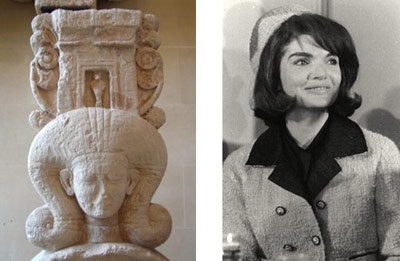
Mrs. Kennedy popularized the ‘flip’ hairstyle of the Egyptian goddess Hathor. Was she a reincarnated Egyptian priestess as her connection to the Isis temple suggests?
I take at face value Omm Sety’s claims that Sety had transfigured or metamorphosed (my terms, not Omm Sety’s) into a being of light who could materialize in human form and dematerialize into his ascended form.
If Sety is indeed a Transfigured or Metmorphosed Man, he possessed the same ability as the resurrected Jesus, who appeared repeatedly to his disciples to deliver Gnosis to them. The difference between Sety and Jesus is that while the Bible simply tells us Jesus resurrected, Sety left a visual record of how he did it.
That’s right.
What I have discovered is that Sety (or more likely his son, Rameses II) left incredible depictions of the technology Sety used to perform his Transfiguration or Metamorphosis into a light being. I call this technology The Osiris Stargate Device (more momentarily).
“In that day shall there be an altar to the Lord in the midst of the land of Egypt, and a pillar at the border thereof to the Lord. And it shall be for a sign and for a witness unto the Lord of hosts in the land of Egypt.”
Isaiah 19:19,20
Long before Mecca or Jerusalem there was Abydos. It was a place of pilgrimage and sanctuary for over 3,000 years.
Known as the ‘Gate to the Underworld’, here is found the incredible Osirion, easily Egypt’s most mysterious place. It’s called the Tomb of Osiris, the Egyptian god of resurrection whose ‘body’ was cut to pieces and then re-membered by Isis. The Egyptian name for Abydos was Abdu, “the hill of the symbol or reliquary,' in which the sacred head of Osiris was preserved.
The archaeologists Flinders Petrie and Margaret Murray discovered the Osirion by accident while excavating Sety's Great Temple of Abydos in 1904 (the year Dorothy Eady was born).
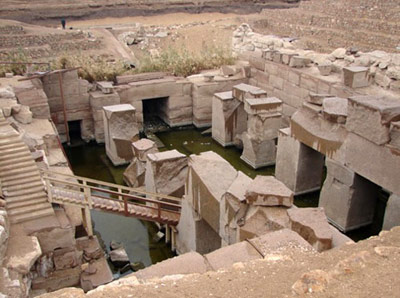
The Osirion
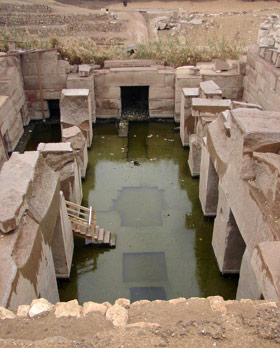
Today, the Osirion is filled with water. Originally, it is thought that something was placed in the rectangular center area
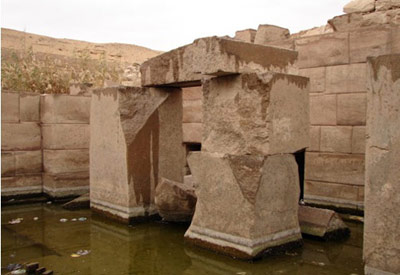
YABADABADOO! Constructed of massive monolithic 50-250 ton red granite pillars, I remarked that the Osirion looks like something out of “The Flintstones”. This inspired one of my guests to promptly label the place ‘Yabadabados’
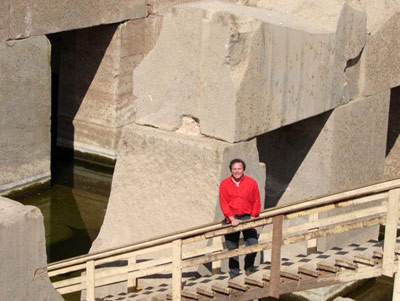
Me standing on the stairs leading to the floor of the Osirion
In the ancient Egyptian story Isis finds Osiris’s head buried at Abydos (rendering it a prototype of Gulgotha, ‘the place of the skull’, where Adam’s skull was buried and where the Crucifixion took place).
The hieroglyph for Osiris’s head features three symbols: the pillar of enlightenment with a serpent levitating upon it, the TET or backbone, and the altar or gateway.
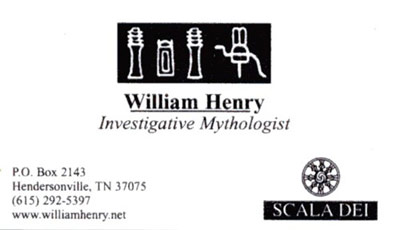
I’ve used the hieroglyph for the head of Osiris on my business card for over ten years and have basically devoted my adult life to discovering its secrets
When assembled, these symbols form a mythic image, symbol or icon of the god and king called Osiris by the ancient Egyptians. Historically, it is referred to as the Ta-Wer or ‘the Bond Between Heaven and Earth’, indicating its function as a ‘ladder’ or ‘stairway to heaven’. It is the sacred Tree of Life. In esoteric Christianity it is the Cosmic Cross of Christ, also known as the Scala Dei, the Ladder to Heaven.
In OSE Dorothy Eady says Sety claimed he had a dream in which Osiris appeared to him, led him to Abydos and told him to build his temple at that spot. On his temple’s exterior wall he etched the symbol for the head of Osiris.
My gut, combined with my research, tells me Sety discovered something of immense importance about Osiris and commemorated this discovery by placing the logo for Osiris’s head on the exterior wall of his temple, the one adjoining the Osirion.
That’s not all.
Inside Sety’s temple at Abydos, in the Osiris Chapel, is the magnificent depiction of Osiris. You won’t find many depictions like this – I’ve been to Paris, NYC, Boston and Egypt to catalog them all (that are public anyway). I’m convinced it is an out of place artifact from another time and place.
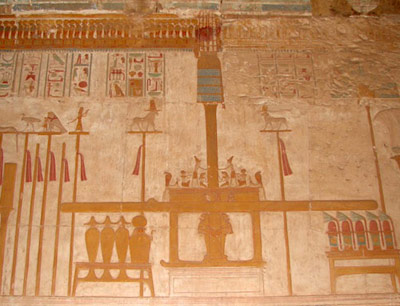
The Osiris Device
Several years ago I began calling it the Osiris Device as the word ‘device’ refers to a technology, a tool and, most importantly, a symbol. Remember, Abydos is known as the hill of the symbol. It should be emphasized that this appellation, Osiris Device or Osiris Stargate Device, does not appear in ancient Egyptian texts. It’s my term and is designed to distinguish my original research and deductions/speculations/opinions about it from previous works. However, I believe this accurately describes its function.
What does this device do? On the opposite wall of the Osiris Chapel at Abydos is the Osiris Device, enhanced, I noticed, with a wormhole-shaped ship of eternity attached to it. Pay particular attention to Sety who appears to have transformed his body into the Osiris Device or is coming out of it. This is a wonderful moment of resurrection.
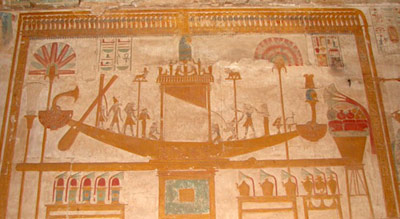
The Osiris Stargate Device
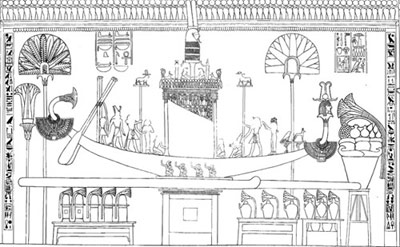
A wormhole-shaped ship is attached to the Osiris Device. Is this an ancient scanning device that projected souls to distant galaxies or other dimensions?
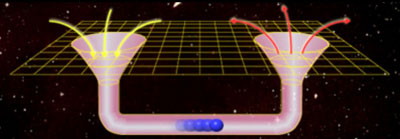
A diagram of a wormhole. Notice the trumpet or lotus-shaped mouths on each end
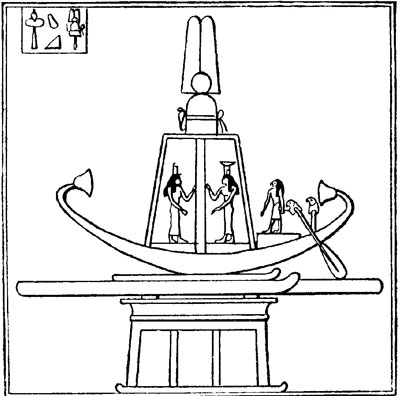
The Osiris Device at Denderah with its wormhole-shaped ship of eternity
The addition of the wormhole-shaped ship suggested to me that the Osiris Device – the ladder or stairway to heaven – is either some form of ancient particle accelerator for opening wormholes or a scanning device that scanned Sety atom by atom and fed that information through the wormhole with instructions to reconstruct, reconstitute or “re-member” him ala the re-membered Osiris on the other side.
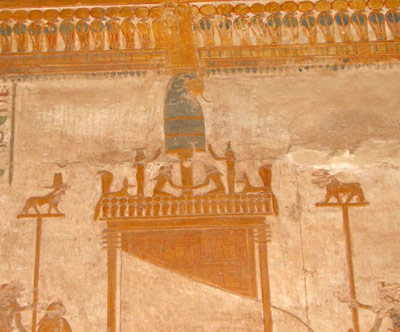
Sety has transformed into the Osiris Device
A wormhole connects a black hole (which sucks everything in) with a white hole (which blows everything out the other side). Once a wormhole is stabilized it opens into Hyperspace, a realm the ancient Egyptians called Aaru or “the Field of the Blessed.” A wormhole is stabilized by threading its throat with “exotic matter,” which forms a spherical shell. Time stands still in the middle of a wormhole. This is exactly the position in which Sety sits in the depiction at Abydos. Sety is portrayed in a sort of shell or cocoon. He has transformed into the ‘mast’ of the wormhole-ship.
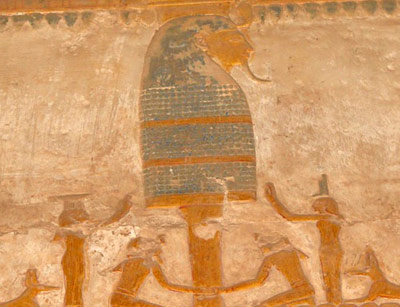
If Sety is enclosed within a shell of exotic matter, it has negative mass and positive surface pressure. The negative mass ensures that the throat of the wormhole lies outside the horizon, so that he can pass through it, while the positive surface pressure prevents the wormhole from collapsing
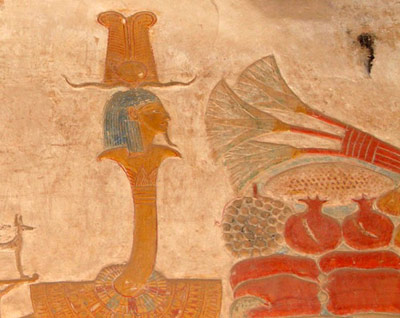
Sety emerges from the other end of the wormhole. The food of life, the fruit from the Tree of Life, awaits him
Based upon the appearance of the wormhole-shaped ship and the transformation of Sety into the Osiris Device, I have proposed that the Osiris Device was, in fact, the Osiris Stargate Device, and that this is a resurrection or Transfiguration scene. Sety is in the process of being resurrected into a being of light.
Thus, what we see on the walls of Abydos is Sety’s resurrection technology.
It’s gratifying to me that engineer John Riley and physicist Dr. Brooks Agnew, who accompanied us on the Stargate Egypt tour, have accepted this premise and have taken such a deep interest in my work. Picking up this great torch of illumination that is the Osiris Device, they are dreaming about building a working model based upon the insights I have proposed. Stay tuned!
You can join me in April of ’08 to visit Abydos and see this incredible device for yourself. You won’t find anything like this anywhere. Only my Stargate Egypt tours can show you the amazing secrets of this device.
http://www.williamhenry.net/egyptfeb08.html

